
Learning to Love Leeches
with
Philip Rowley
Website
|
Email
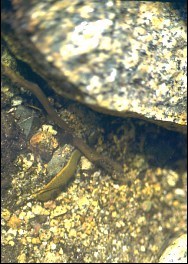
Leeches love to skulk amongst the bottom debris and structure while hunting for their next meal. Notice the distinct orange racing stripe along side of this leech.
|
It had not been a fishing trip to remember. We were hoping to take advantage of the early summer caddis emergence. Instead we found wind, cool weather and moody fish. We even had snow! This wasn't November or October but late June. One evening more out of a sense of duty we tested our luck once more. Things began in the same fashion as the rest of our excursions. Slow. The sun was beginning to set. I changed my caddis pupa pattern to a small #8 mohair leech pattern and made a long cast up onto the shoal. Finally I began to get a number of short takes to my fly, but I could not manage a hook up. I muttered under my breath, "Come on take it!" The answer to my request came as I felt a savage take that shook my rod to the core. My fly line tore out of my hands. Within seconds I was into my backing and wondering if the run was ever going to stop. Five minutes later after a spirited battle the Kamloops rainbow slid quietly into my net. I admired the beauty of this magnificent fish and gently released her to fight again. Buoyed by this success I re-cast my fly in the hopes of a repeat performance. By now the sun had set and darkness was all around. My luck had finally changed. I enjoyed my best fishing of the trip that evening catching and releasing numerous trout, all over 3 pounds with the largest in excess of 6 pounds. My evening fishing did not end until well after midnight when I finally succumbed to the cool night air and the call of a warm bed.
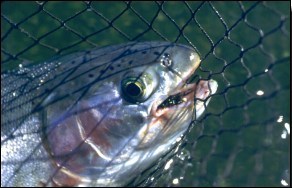
Leech patterns are great in the evenings, during the spring immediately after ice off and the late fall as fish prowl the shallows in preparation for the on coming winter. In the high heat of summer a leech pattern worked slow and deep can provide steady action.
|
Fishing leech patterns has saved countless trips for me over the years. They have consistently worked time and time again. You can fish Leech patterns at any time of the year. The patterns are simple and relatively easy to fish. They are a great way to probe a new lake. A true stillwater staple for trout in stillwaters, leech patterns should not be missing from anyone's fly box.
Leeches belong to the phylum
Annelida
, class
Hirudinea
. They are distant cousins to aquatic earthworms and the more familiar common garden worm and night crawlers.
The body of the leech is similar to the common earthworm. The leeches' segmented body and the strong muscular structure provides support and form. The leeches' body is, "dorso-ventrally flattened". Meaning they are flat from top to bottom. Leeches are able to change their appearance from long, snakelike bodies to short, squat and contracted in an instant. This is one of their primary defensive reactions. Leeches swim with their bodies extended. The rear of the body is wider and flatter than the front. This paddle like appearance makes the leech a competent swimmer. Leeches swim in an undulating fashion and are quite rhythmic in their motion. Leeches range in size from less than one inch to over a foot. However sizes from 1 to 6 inches are more common and I would say trout seem to prefer those leeches that are 3 inches or less.
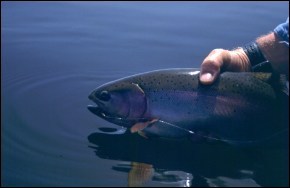
A chunky rainbow that socked a well presented leech pattern.
|
Leeches are blind, but they possess an acute sense of smell and touch. The body of the leech has a unique pair of suckers. One is at the posterior (rear) while the other is at the anterior (front) end. The primary use of the posterior sucker is to secure the leech to the bottom structure and to move along the bottom in an inchworm like motion. The primary use of the anterior sucker is for probing and feeding, although it also assists with movement along the bottom.
Leeches come in a host of colors. The most common colors include black, brown, olive and maroon. Mottled combinations of these colors are quite common and your patterns should take this into account. As with most aquatic organisms the leeches' underside is lighter than its' dorsal surface, this should be a consideration at the vise too.
Contrary to popular belief not all leeches are evil bloodsuckers. Actually very few species in North America rely on blood for food. The majority of leeches feed upon carrion, plants, other invertebrates such as scuds, and chironomid larvae. Even other leeches. Through aquarium study leeches seem to have a particular appetite for snails. It is surprising how fast a snail can motor when approached by a curious leech.

Evenings are a great time to fish leeches often right into the early hours of the morning. This is the time to hook into some huge trout.
|
Leeches are available in a wide variety of water types. They do have however a limited tolerance for very acidic water. Leeches are most abundant in depths of less than 15 feet, although it is not uncommon to find them as deep as 50 feet or more. They spend the majority of their life under rocks and debris or by burrowing into the mud or sand bottoms. Night owls by nature leeches become most active at night or during low light conditions. From time to time however I have seen leeches swimming confidently in open water in bright sunlight. This bold swimming pattern does not go unnoticed by the trout.
Leeches are hermaphroditic. Meaning they contain both sex organs and are capable of fertilizing their own eggs. Typically leeches mate in pairs during the spring and early summer. Underwater structure such, as plants or wood debris are favorite spots to attach the fertilized eggs. Other favorite spots include the mud or sand bottom. There is little know about the life span of leeches although they can live over ten years. The leeches spend their entire life underwater making them a year round menu item.
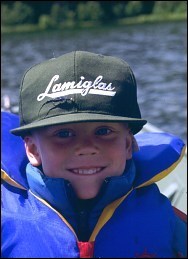
The author's son Brandon knows the value of a good leech pattern, look just above the brim of his hat.
|
When tying and developing effective leech patterns you do not need to get complicated, a simple pattern offering size, shape, color and movement is all that you need. Most anglers use some form of a woolly bugger and do quite well. I tend to use patterns specifically aimed at imitating leeches. When it comes to size I only use small patterns, the largest leech pattern I tie is a size #6, 3xl. Remember stillwater trout seem to show a preference for leeches 3 inches or smaller. Make sure your leech patterns offer a slim natural looking profile. A 2 to 3 inch leech is only the diameter of a pencil when fully extended. Bulky over dressed patterns are not necessary. I weight ninety percent of my leech patterns. When weighting your patterns you need to only weight the front 1/4 of the hook shank creating the undulating motion of a natural leech. I do know of fly tiers who prefer to weight the rear portion of the hook to achieve the undulating motion. I use red nail polish to paint the eye of the hook to easily identify my weighted patterns. In British Columbia and Washington bent hook leeches are popular. A hook with the front 1/4 bent and weighted causes the fly to ride upside down and makes the fly practically weedless. There is a risk with the hook riding point up that it will cause injury to smaller fish.
I prefer to use lead wire substitutes or metal beads to weight my leech patterns. Any leech pattern can have a bead head added to it. I make good use of beads when tying my own patterns. Take advantage of the variety of beads available; black, gold, copper, brass and silver beads all can be successful. Sometimes the flash of the copper, gold or silver beads can be the difference between a good day and a great one.
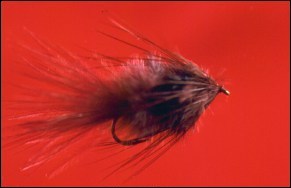
Filoplume Leech
|
Materials used for constructing leech patterns should be soft to suggest the undulating nature of the leech. Some of the best materials include marabou, rabbit fur, and my personal favorite filoplume. Filoplume is the secondary marabou like feather found on game birds like the Ringneck pheasant. Filoplume is brittle. If you spin them in a dubbing loop you can create a durable, breathing body. Sometimes the marabou tails of leech patterns can wrap around the hook bend. This defeats the swimming action of the fly. To remedy this try using a short tuft of squirrel hair, Angel Hair or a loop of monafilament tied in at the rear of the hook. This prevents the softer marabou from wrapping around the hook bend.
Other effective materials include Mohair yarn and dubbing. Popular dubbing mixes include Antron blends, crystal seal and Partridge's SLF. Don't be afraid to mix the various colors in a dubbing blender. A dubbed leech makes a simple and deadly leech pattern. Once the pattern is complete use a Velcro brush to roughen up the body and sweep the fibers rearward to simulate the leech. Remember to sweep the fibers rearward when creating a body of mohair. This eliminates the fibers from becoming trapped as you wrap the material forward. A Velcro brush puts the finishing touches to the fly.
Under certain light conditions' leeches give of an iridescent sparkle. Selective use of Flashabou or Crystal Flash in the tail imitates this feature. Don't forget about Sparkle Chenille bodies either. For those wishing to use a more natural material, peacock herl, peacock sword or the peacock breast feather work great but their one failing is durability.
Anglers often experience great success dragging a favorite leech pattern behind their boat, float tube or kick boat. Leeches do not have to be labor intensive to fish. My favorite method to fish them is from an anchored boat using either an intermediate or Stillwater line using a 9 to 12 foot leader. I prefer these lines because of their retarded sink rate. Although it takes a while for these lines to sink in deeper waters once at depth I can retrieve them at a slow pace and at a consistent depth. In most stillwater situations depth is often the key factor as trout are opportunists when it comes to food but selective on depth. I use the sweep hand on my watch to count my pattern down. Through a process of elimination and a little luck I should be able to find a willing fish or two. I have two favored retrieves a steady hand twist and a slow strip. By varying the pace and time between pulls I can get a varied presentation. Just try to remember what worked after the excitement of hooking a fish dies down. It's not always easy to do.
Leech patterns are often successful all season long and tend to attract the larger trout. The strikes are fierce. They are an exciting and rewarding way to fly fish both still and moving waters. Everyone's fly box should include some leech patterns. I know I never leave home without them.
Dressings for featured fly patterns
Filoplume Leech
-
Hook: Tiemco 5263 #10-#6(Weighted)
-
Thread: Color to Match Body
-
Tail: Marabou
-
Body: Filoplume feathers spun together in Dubbing loop
-
Hackle: Pheasant Rump to Match Body
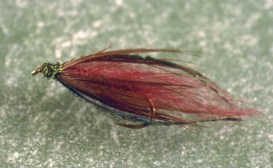
Mohair Blood Leech
|
Mohair Blood Leech
-
Hook: Tiemco 5263 #10-#6(Weighted)
-
Thread: Black or Maroon
-
Body: Maroon Mohair Yarn, brushed out
-
Hackle: Pheasant Rump
-
Topping: Peacock Herl or Sword
-
Beard: Peacock Herl or Sword
-
Head: Peacock Herl

|











